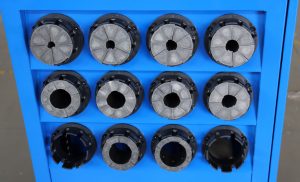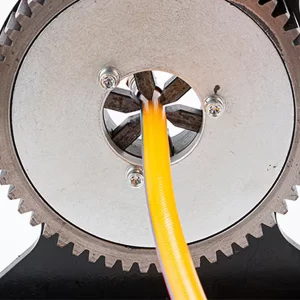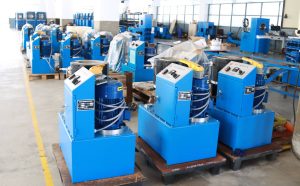Choosing the right size hydraulic hose crimper is crucial for operational efficiency and safety. This article dives deep into understanding what size hydraulic hose crimper fits your operation best. We will cover essential factors affecting crimper size, how to assess your needs accurately, and practical examples to guide your decision. Hydraulic hose crimpers come in various sizes, each designed for specific hose diameters and production volumes. Picking the correct size ensures reliable crimps, prevents equipment damage, and improves productivity. Whether you’re in a small maintenance shop or managing large-scale industrial production, this guide will equip you with the knowledge needed to make the right choice.
1 What key factors determine the right size hydraulic hose crimper?
Several factors influence the choice of hydraulic hose crimper size. First, hose diameter plays a significant role because different crimpers accommodate varying hose sizes. If you mainly work with large-diameter hoses, a bigger crimper with higher tonnage is necessary. Conversely, smaller hoses require smaller, more precise crimpers. Next, production volume impacts the crimper choice. High-volume operations benefit from automatic or semi-automatic crimpers that handle larger hose sizes quickly, while low-volume users might prefer manual crimpers. Additionally, the types of fittings you frequently use matter since some require specialized dies or crimping forces. Power source availability and workspace size are practical considerations as well. But here’s the kicker: ignoring any factor can lead to inefficiency or costly mistakes.
Table 1: Key Factors Influencing Crimper Size Selection
| Factor | Impact | Example |
|---|---|---|
| Hose Diameter | Determines crimping force | 1/4” hoses vs. 2” hoses |
| Production Volume | Affects crimper automation | Manual for low volume, automatic for high volume |
| Fitting Types | Requires specific dies | Specialty fittings need custom dies |
| Power Source | Limits machine options | Electric vs. hydraulic power |
| Workspace Size | Affects machine footprint | Compact crimpers for small shops |
2 How does hose diameter affect crimper size choice?
Hose diameter is arguably the most critical factor when selecting a hydraulic hose crimper. Larger hose diameters require more substantial crimping forces and bigger dies, which means the crimper must be capable of exerting sufficient pressure. For example, a crimper suitable for 1/4” hoses won’t perform well with 2” hoses. On the flip side, using an oversized crimper for small hoses might result in inefficiencies and unnecessary costs. Production plants often stock hoses of various diameters, so choosing a crimper with interchangeable dies or adjustable force settings can be beneficial. What’s the real story? The match between hose diameter and crimper size directly impacts the quality and durability of hose assemblies, preventing leaks and failures.
Table 2: Hose Diameter vs. Crimper Size Guidelines
| Hose Diameter | Recommended Crimper Size | Crimping Force Range (tons) |
|---|---|---|
| 1/4” – 3/8” | Small | 5–15 |
| 1/2” – 3/4” | Medium | 15–30 |
| 1” – 2” | Large | 30–70 |
| 2” and above | Extra Large | 70+ |
3 What role does production volume play in selecting crimper size?
Production volume heavily influences which hydraulic hose crimper fits best. For low-volume applications, manual or semi-automatic crimpers suffice. These machines offer flexibility and lower upfront costs, making them ideal for small maintenance shops or low-throughput environments. However, for high-volume production lines, automatic crimpers with higher capacities and faster cycle times significantly improve productivity. Case studies show companies investing in automated crimpers reduced labor time by 40% and improved consistency. But here’s the kicker: overestimating volume needs can lead to overspending, while underestimating may cause production bottlenecks. Therefore, accurately forecasting your production volume and selecting the appropriate crimper size is crucial for operational success.
Table 3: Production Volume vs. Crimper Type
| Production Volume | Recommended Crimper Type | Benefits |
|---|---|---|
| Low (<50 hoses/day) | Manual | Cost-effective, flexible |
| Medium (50–200/day) | Semi-Automatic | Balanced speed and cost |
| High (>200/day) | Fully Automatic | High speed, consistent quality |
4 How do hose materials and fitting types influence crimper sizing?
The materials used for hoses and fittings can affect crimper size selection. Rubber hoses generally require different crimping pressures compared to thermoplastic or composite hoses. Additionally, specialized fittings like reusable or high-pressure connectors may need precise crimping force and specific dies. For example, steel wire-reinforced hoses typically need larger, more powerful crimpers. Multiple case studies highlight how mismatched crimpers led to poor seal integrity and premature failures. Ready for the good part? Selecting a crimper compatible with your hose and fitting materials not only ensures safety but also maximizes equipment lifespan and operational efficiency.
Table 4: Hose Material and Fitting Types vs. Crimper Requirements
| Hose Material | Fitting Type | Crimping Pressure Required | Recommended Crimper Size |
|---|---|---|---|
| Rubber | Standard fittings | Moderate | Medium |
| Thermoplastic | Reusable fittings | Low to moderate | Small to Medium |
| Steel wire-reinforced | High-pressure fittings | High | Large |
5 How does the work environment impact crimper size and type?
Work environment conditions significantly impact the choice of hydraulic hose crimper size and type. Field operations often demand portable, rugged crimpers that can withstand harsh conditions and limited power sources. In contrast, controlled factory environments can support larger, more sophisticated equipment. For example, mobile repair units benefit from compact, battery-operated crimpers. Industrial plants with dedicated workspaces prefer stationary, automated crimpers for efficiency. But here’s the kicker: ignoring environmental factors can cause frequent breakdowns and costly downtime. Companies successfully match their crimpers to environments, optimizing maintenance schedules and operator safety.
Table 5: Work Environment vs. Recommended Crimper Types
| Environment Type | Crimper Size | Key Features |
|---|---|---|
| Field Service | Compact, portable | Battery-powered, rugged design |
| Industrial Plant | Large, stationary | Automated, high throughput |
| Workshop | Medium-sized | Semi-automatic, flexible |
6 How should budget constraints guide your hydraulic hose crimper selection?
Budget constraints are always part of the decision-making process. Smaller, manual crimpers typically cost less upfront but may increase labor costs due to slower operation. Automatic crimpers require higher initial investments but yield better long-term returns by reducing errors and downtime. For example, a mid-sized workshop invested in a semi-automatic crimper and saw a 25% reduction in assembly time. What’s the real story? Careful cost-benefit analysis that considers both purchase price and operational savings ensures the best value. Financing options and leasing may also make higher-end crimpers accessible without straining budgets.
7 What sizing considerations are unique to hose repair vs. production?
Hose repair operations and production lines have different crimper sizing needs. Repair shops require versatile crimpers that handle various hose sizes quickly, often with manual or semi-automatic machines. Production lines prioritize speed and consistency, favoring automated, larger crimpers with minimal setup times. Case studies show repair shops using compact crimpers reduced turnaround times by 30%. Meanwhile, production plants improved output by 50% with automated systems. Ready for the good part? Understanding these distinctions helps businesses invest in crimpers that align with their operational goals and customer expectations.
8 How do die change mechanisms affect crimper efficiency and size choice?
The mechanism for changing dies on a crimper impacts operational efficiency. Manual die changes can be time-consuming, reducing throughput in high-volume environments. Automatic die change systems save time and enable multi-size hose crimping without lengthy downtime. For example, automated die systems can reduce changeover time from 10 minutes to under 2. What’s the real story? Investing in crimpers with fast die changes improves workflow and is particularly important for operations with diverse hose sizes. When combined with the right crimper size, it ensures maximum productivity.
9 What safety standards influence crimper size and design?
Safety standards dictate features on hydraulic hose crimpers to protect operators. Larger crimpers often include safety shields, emergency stops, and ergonomic controls. Compliance with OSHA and industry regulations is mandatory to prevent accidents. For instance, high-capacity crimpers incorporate automatic shutoff when a die is misaligned. But here’s the kicker: overlooking safety can result in injuries and costly legal issues. Selecting crimpers with certified safety features and matching size to operator capability ensures both compliance and worker well-being.
10 How do power requirements affect your choice of crimper size?
Power source availability influences crimper size and functionality. Electric crimpers suit fixed installations with stable power, while pneumatic or battery-operated crimpers work better in remote or mobile settings. Larger crimpers need more powerful sources to generate required crimping forces. Case studies reveal that shops with inconsistent power supply prefer pneumatic crimpers for reliability. What’s the real story? Evaluating power infrastructure upfront prevents costly modifications and ensures continuous operation.
11 What are the workspace and footprint implications of crimper size?
Physical space constraints affect the crimper you can accommodate. Compact crimpers are ideal for small workshops or mobile units, while larger industrial crimpers need dedicated space. In tight environments, portable crimpers help maintain workflow without sacrificing quality. Industrial plants with ample space benefit from floor-standing models with advanced automation. But here’s the kicker: ignoring space needs causes workflow bottlenecks and safety hazards. Planning layout alongside crimper size optimizes efficiency and operator comfort.
12 How does operator skill level influence crimper size and complexity?
Operator experience dictates the ideal crimper complexity and size. Skilled operators handle advanced, automatic crimpers that maximize throughput. Beginners may require simpler manual or semi-automatic crimpers with straightforward controls. Training investment also varies by crimper type. Companies with mixed skill levels benefit from crimpers offering adjustable automation. Ready for the good part? Matching crimper complexity to workforce ability reduces errors and improves morale.
13 What industry standards must be considered when sizing crimpers?
Industry standards such as SAE and ISO influence crimper features and sizing. Aerospace and automotive sectors demand high precision and traceability, affecting crimper capabilities. For example, crimpers used in aviation require documented crimping parameters and specialized dies. Meeting these standards may require investing in larger, more advanced crimpers. What’s the real story? Adhering to standards ensures product quality and opens market access.
14 How can future-proofing your crimper size benefit your operation?
Planning for future needs means selecting scalable crimpers. Modular designs allow adding features or capacity as business grows. Some crimpers support software upgrades enhancing data tracking. Case studies show that investing slightly above current needs avoided costly replacements later. But here’s the kicker: future-proofing protects your investment and accommodates evolving production demands.
15 How to optimize your investment in hydraulic hose crimper sizing for maximum ROI?
Maximizing ROI involves balancing upfront cost with operational gains. Investing in the right size reduces scrap, rework, and downtime. Maintenance ease and spare part availability also factor into long-term costs. Examples highlight companies saving 20-30% on total costs by selecting appropriately sized crimpers. Ready for the good part? Strategic sizing coupled with proper maintenance maximizes efficiency and profitability.
Conclusion
Choosing the right size hydraulic hose crimper shapes your operational success. Consider hose diameter, volume, fittings, environment, and budget carefully. Matching crimper size to these factors ensures quality crimps, safety, and productivity. Investing smartly today prevents costly mistakes tomorrow. Equip your business with knowledge and the right tools to thrive.
FAQ
Q1: What is a hydraulic hose crimper?
A hydraulic hose crimper secures fittings onto hoses by compressing sleeves, ensuring leak-proof hydraulic connections.
Q2: How does hose diameter affect crimper size?
Hose diameter determines the crimping force and die size required, directly influencing the crimper size selection.
Q3: Can one crimper handle multiple hose sizes?
Many crimpers offer interchangeable dies allowing handling of multiple hose diameters with one machine.
Q4: What power sources are used in hydraulic hose crimpers?
Crimpers can be manual, electric, pneumatic, or battery-operated depending on application and location.
Q5: Why is die compatibility important?
Die compatibility ensures proper crimping pressure and fit for different hose fittings, crucial for reliability.




